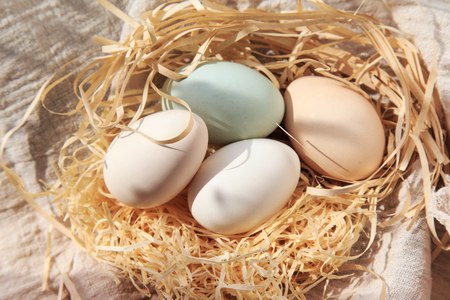
Goose flesh makes a delightful dinner entrée and the feathers can be used to make a comfortable pillow, but the eggs are yet another reason to raise geese. When we don’t need them for hatching, we use eggs from all our flock – turkey, duck, chicken, goose, guinea and occasionally pheasant. Nothing goes to waste. All types of eggs are interchangeable in any dish.
Goose egg consumption is nothing new.
Richard Hosking claims that goose eggs were the most highly prized in ancient Ireland. “In early Ireland, goose eggs were a very sought-after luxury served at banquets on dishes of silver and gold.” Other cultures shared this regard for the goose egg. In American Cookery [April 1910] we find, “The keen, sharp-tongued Dane characterizes the egoist, who always helps himself to the best morsels,” with the following neat phrase: “Eggs are eggs, said the sexton, and helped himself to a goose egg.”
James Jennings penned this account [1837], “About sixty years ago goose eggs, in Somersetshire, [England] were among the farmers in the lowland districts contiguous to the extensive moors then unenclosed, a common dish.” He noted that it took longer to boil a goose egg due to its size.
Hannah Glass noted in her Professed Cook, the size of goose eggs compared to those of hens. While she did not specify the types of eggs being used in her receipts (recipes) their use was affirmed by making the comparison.
An article in The Farmer’s Monthly Visitor [May 31, 1841] commented on a farm woman the author observed preserving eggs for winter use by packing them in fine wood ash that the 14 dozen eggs she put away consisted of peacock, turkey, goose, duck and hen eggs.
When asked for an idea pertaining to the kitchen for a table at a fair, Janet McKenzie Hill suggested creating the appearance of a Dutch house with costumed participants offering, among other things, goose eggs and smoked goose sandwiches.
There is a larger proportion of yolk to white and the yolks are generally creamier. They are especially good for making pasta, souffle and baked goods.
Before my readers rush to buy a goose expecting a year-round supply of eggs, let me point out that geese generally lay in the spring and then about 40 eggs. Depending on how many females one has, the supply of eggs varies.
For me, the best way to preserve eggs is to freeze them. I crack them into a small plastic bowl, freeze them, then pop them out of the bowl, wrap them in aluminum foil and put the packets in a gallon size zip-lock bag. I freeze hen’s eggs three per packet, which is the number needed for most recipes.
One goose egg is equivalent to two hen’s eggs.
To test the freshness of eggs when one isn’t sure, place the egg in a bowl of water. It should lie on its side, neither rising to the top nor standing on end. As careful as I am to gather them fresh, a hen has been known to hide an egg under her bedding and kick it out on a whim. Testing the eggs in water as they come from the refrigerator can eliminate surprises.
“Turkey eggs are almost equal to those of the hen—not quite so mild. Goose eggs are large and agreeable to the taste. Duck eggs are richly flavored. The white is of a bluish tint, and will cook in less time than that of the hen. Guinea-hen’s eggs are smaller and more delicate than those of the common hen . . .”
“Chinese goose eggs are delicious to eat and have no strong flavor whatsoever . . . When hard-boiled the white of Chinese goose eggs becomes opaque, otherwise they are almost indistinguishable from hens’ eggs. They are particularly good scrambled and in omelets and are vastly preferable to hens’ eggs for making cakes and puddings. Not only does one full-sized egg equal three hens’ eggs in size, but it definitely makes a lighter cake. A useful recipe for a sponge cake is as follows: Take two Chinese goose eggs, 6 oz. Of sugar and 6 oz. plain flour. Beat the eggs and sugar until creamy, and fold in the flour as lightly as possible. Put the mixture into two greased . . . tins and bake in a moderately hot oven for ten to fifteen minutes.”
There are so many ways to present boiled eggs, but first they must be cooked.
“Put the eggs [turkey, geese and duck] into a bowl filled with boiling water for five minutes, keeping the bowl covered tight and in a hot place; then pour off the first water, replace it with more boiling water, and let them stand for five minutes longer; serve them like ordinary boiled eggs; or, actually boil the eggs for five minutes: either of these methods will cook the eggs medium hard. From ten to fifteen minutes boiling will cook the eggs hard, according to their size. Duck eggs will cook in less time than turkey or goose eggs.”
Perhaps the best closing for these musings for anyone unconvinced of the wholesomeness of eggs outside those of the hen is to quote James Jennings. “Duck and goose eggs, as well as some others of the bird tribe, are of a stronger taste and consequently not so delicate as those of the hen; but it is a remarkable fact, as far as hitherto the eggs of birds are known, not one of any of the tribe is absolutely unwholesome.”

Philo, Edgar Woodruffe. “The Philo System of Progressive Poultry Keeping” 1908.
Corson, Juliet. “Miss Corson’s Practical American Cookery and Household Management” 1885.
Jennings, James. “Two Thousand Five Hundred Practical Recipes in Family Cookery” 1837.
Owens, Frances Emugene. “Mrs. Owens’ New Cook Book and Complete Household Manual” 1897.
Hosking, Richard. “Eggs in Cookery”. 2006
Hill, Janet McKenzie. “The Boston Cooking School Magazine of Culinary Science” June-July 1906.
Glass, Hannah. “Professed Cookery” 1792.

